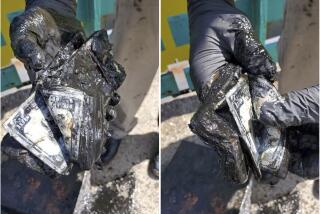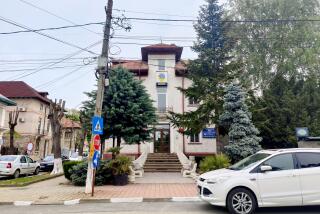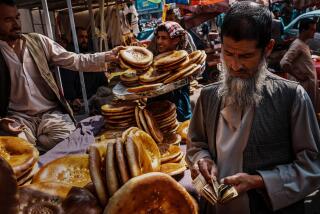Computers Become the Key to Counterfeiting
- Share via
Equipped with little more than home computers and $100 scanners, amateur counterfeiters have been sending reams of bogus currency into the marketplace. The government is hoping that the new $20 bill, the most commonly counterfeited denomination in the United States, will put a dent in the illicit copying.
Less than 1% of the fake money seized nationally in 1995 was computer-generated, but about 40% is today, according to U.S. Secret Service figures. In Los Angeles County, $4.2 million was passed in 1997, compared with $2.7 million four years before; in Orange County, the number more than doubled during that time, from $288,000 to $765,000.
The same technology that lets personal computer users scan and print photo-quality copies of family snapshots has made it tempting for some to try duplicating things that are illegal to copy--like money.
Among recent cases: a Yorba Linda real estate appraiser worried about his finances who set up shop in his garage, two college freshmen in Kentucky accused of printing bills in their dorm, and a Simi Valley man charged with producing more than $1,000 in phony $20 notes on his company’s personal computer.
“What we’re seeing now is not just counterfeiters with criminal histories, but regular people,” said Robert Brenner, the agent in charge of the Santa Ana office of the Secret Service.
Federal officials, meanwhile, are trying to make bills harder to copy. Although the most obvious change in the new $20 is the larger portrait of Andrew Jackson, it has difficult-to-duplicate details such as faint identifying markers in the paper.
The new $20, which began circulating in September and has by now found its way into the hands and wallets of most Americans, follows redesigns of the $100 note in 1996 and the $50 bill last year.
Although the $100 bill is not as commonly used by consumers in the United States, it is the favorite denomination of currency criminals abroad. And the new $100 bill has had a major dampening effect on counterfeiting there. In 1995, before the new note was introduced, more than $231 million in bogus U.S. money was passed internationally; by last year, that amount had dropped to slightly more than $64 million.
Government officials hope that the new $20 bill will have the same effect domestically.
“It’s the note we most readily use,” said Jim Mackin, a Secret Service spokesman. “It’s the bill of choice--the most used note after the $1 bill.”
The paper is one of the few elements of fake-money production that desktop counterfeiters are hard-pressed to duplicate.
Most buy high-quality paper similar to that used for actual currency, which can be purchased legally from the manufacturer. But salesclerks who pay attention generally can feel the difference.
Among the new bill’s features are a subtle watermark next to the portrait of Andrew Jackson and a polymer thread visible only when the bill is held up to the light. Both are embedded in the paper.
Nationwide, more than $31 million in counterfeit money found its way into circulation last year, most of it caught by banks. By that time, the person who last had the bill--usually a shop owner--was stuck with the loss.
Los Angeles County routinely holds the first or second spot on the Secret Service’s weekly list of the nation’s leading centers of counterfeit money production. Orange County often makes the top five.
In the fiscal year that ended in July, 105 people were arrested in 10 separate cases of money counterfeiting in Los Angeles County. Every case involved use of either a computer or an office copier.
Real estate appraiser Kevin Metcalf, hurting after the loss of a major client, decided to set up shop in his Yorba Linda garage with the goal of printing bogus $20 bills that he and a cohort planned to spend in Las Vegas. He did succeed in passing several phony notes at fast-food restaurants in the San Fernando Valley, prosecutors later said, but an anonymous tip led to a sting operation that may land Metcalf in prison.
Brock Christner, a Simi Valley resident, was arrested with two companions last year after police raided the Moorpark company at which he worked. Police said the 20-year-old man used a personal computer at the company to print fake $20 bills on heavy printer paper. Eventually he pleaded guilty and served four months in jail, a sheriff’s spokesman said.
And a Florida man was arrested, also in 1997, after authorities confiscated a personal computer and $117,000 in bogus $20s, $50s and $100s from his Simi Valley storage locker.
The inkjet counterfeiting jobs are generally lower in quality than those produced through more elaborate and expensive offset printing operations. The paper is usually thinner or stiffer than the real thing, the printing fuzzier and the colors slightly off. White areas are filled with tiny dots instead of the minuscule red and blue security fibers found in government-issued money.
“If people just took the time to look at each individual bill rather than accept it, they can usually see the difference,” Brenner said.
Steven McGonigal, head cook at Rumours Cafe in Long Beach’s Belmont Shore, said counterfeit $20s and $50s recently cost his store $300 in a single week. “One Saturday we had four of them,” he said. “It was really discouraging.”
Heidi Miller, owner of a small boutique in Costa Mesa’s South Coast Plaza, said she encountered only two counterfeit bills during the first six years she was in business. This year--her seventh--she has already seen three, all of them $100 notes.
“It’s like someone reaching right into my purse and stealing the money,” Miller said. “It always hurts. It digs right into the rent and my ability to pay my bills.”
Working with the Secret Service, many store owners and managers now conduct seminars to teach employees how to detect bogus bills. Imperial Bank, based in Inglewood, holds regular training sessions for tellers on what to look for. And at South Coast Plaza, shopkeepers are kept informed of the latest counterfeiting finds and preventive techniques through regular memos from the mall’s security department.
Generally, retail workers are taught to examine currency for unusual markings or textures. Some merchants have special pens treated with a chemical that turns brown on contact with genuine currency because of the paper’s content.
Other than obtaining the paper, the process of making money is amazingly simple.
Counterfeiters scan the copy of a real bill onto the hard drives of their computers, using software that can be purchased from most computer stores. Then they print copies with an inkjet printer--three to a page. By carefully noting the placement of the bills on the paper, they can turn the paper over, return it to the printer and produce the other side of the bill.
Southern California isn’t the only place it’s happening--counterfeiters throughout the country are getting into the act at very young ages.
In one typical case, two freshmen at Western Kentucky University were indicted earlier this year on charges of making and passing more than $800 in phony $20 bills at local convenience stores. According to the indictment, the two had produced the notes on a personal computer in a campus dormitory.
Authorities in Bay City, Mich., recently traced counterfeit $10 bills to the home of a 15-year-old boy who had allegedly bragged to classmates about producing them on his computer.
And last year police in Weston, Mass., uncovered a counterfeiting scheme involving five teenagers after finding electronic images of $20 bills on their high school computers. Although no charges were filed, the students were disciplined and the school tightened its policies regarding the student use of scanners.
Not all counterfeiters are able to avoid legal consequences, however. In Yorba Linda, real estate appraiser Metcalf awaits sentencing after his conviction on five counts of conspiring to pass and possess counterfeit currency and securities. Metcalf--a married father of two who has no prior police record--faces a maximum of 65 years in prison, said James W. Spertus, the assistant U.S. attorney who prosecuted the case.
He will probably serve considerably less time than that, said experts familiar with the field. John Barton, Metcalf’s lawyer, would not comment on specifics of the case. He has represented others accused of counterfeiting, however, and says that the law is little deterrent.
“The penalties for counterfeiting are substantially less than for bank robbery,” Barton said. “You’d have to be a fool on drugs to go rob a bank--it’s a lot easier to manufacture money than to steal it.”
(BEGIN TEXT OF INFOBOX / INFOGRAPHIC)
The $20 Makeover
The new $20 bills issued in September represent the latest attempt by the federal government to make currency harder to counterfeit. Southern California is a leading producer of “funny money”--most of it being $20s, $50s and $100s. New-look $100 bills were issued in 1996 and new $50s last year. Here are some of the features incorporated into the new $20s to discourage counterfeiters:
Portrait: Enlarged with added detail to make duplication harder; moved off-center to make room for watermark
Watermark: Identical to portrait but visible only when held up to light; actually in the paper, not printed on it
Fine print: Lines behind portrait hard to duplicate
Color-shifting ink: Number in lower right front appears green viewed straight on, black at an angle
Microprinting: Extraordinarily small words (“USA 20” within the lower left corner number, “United States of America” along lower edge ornamentation of portrait) are hard to duplicate
Thread: Thin thread running from top to bottom to the left of the portrait visible only when held up to a light source and glows green under ultraviolet light; “USA TWENTY” and U.S. flag appear on both sides of bill; thread is embedded in paper
****
COMPUTER AID
Advanced computers have proved to be such great tools that now nearly half of counterfeit money is generated by keyboard.
Counterfeit money generated by computer nationwide:
1998: 40%
Amount of counterfeit money passed in Los Angeles County (by fiscal year, in millions
‘97: $4.2
Source: U.S. Secret Service
Researched by DAVID HALDANE / LOS ANGELES TIMES
More to Read
Inside the business of entertainment
The Wide Shot brings you news, analysis and insights on everything from streaming wars to production — and what it all means for the future.
You may occasionally receive promotional content from the Los Angeles Times.










